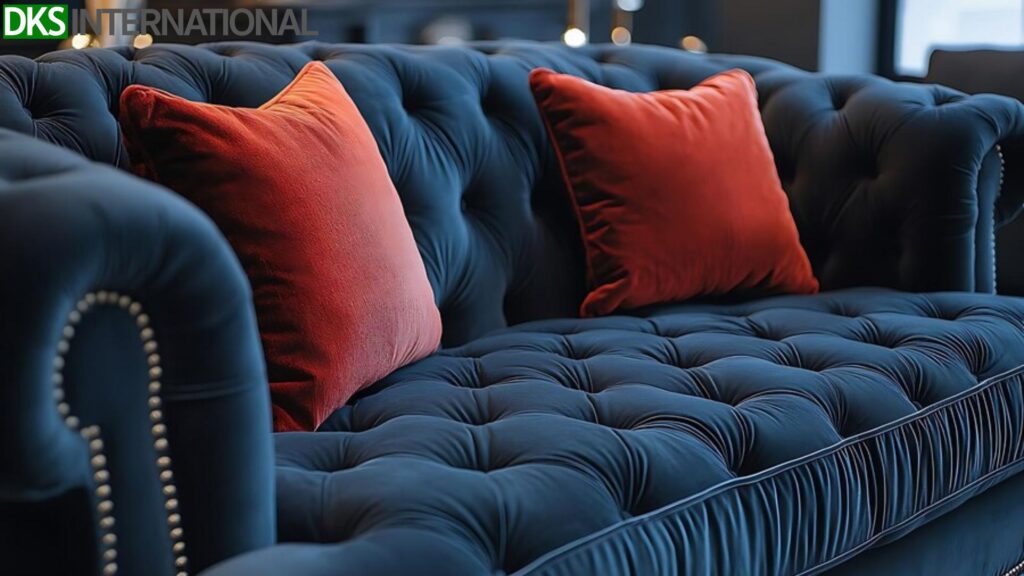While trying to give your living space the perfect form of decoration, sofas are likely to offer major points. The upholstery fabric adds to the beauty and grace in it besides creating comfort and strength. Sometimes, selecting the best sofa upholstery fabric for your home can become pretty confusing. This guide will help you make the right selection with ease.
1. Sofa Upholstery Fabric Types
There are various kinds of fabrics, all with their benefits; hence you can use the same to choose the right one according to your needs.
- Cotton: Cotton is light and soft, comfortable, and airy. It can be fragile compared to most fabrics.
- Linen: Linen is very cool and fashionable but wrinkles easily. Use it in low-traffic areas.
- Velvet: Velvet creates the ultimate tactile sensation and rich texture, but it will require higher maintenance.
- Leather: Leather is for durability and ageless style, which makes it absolutely a great choice for homes with pets and children.
- Microfiber: Microfiber is stain-resistant and easy to clean, which is practical for high-traffic home areas.
2. Durability Depending on Your Lifestyle
The upholstery fabric for your sofa should be based on your lifestyle. Thus, a home with kids and pets requires something other than a formal quiet space.
- For High-Traffic Areas: Use heavier fabrics such as leather or microfiber. They do not wear or stain easily.
- For Low-Traffic Areas: You can opt for softer, gentler fabrics like cotton or linen.
- For Pet-Friendly Homes: Use pet-resistant fabrics such as leather, microfiber, or tightly woven synthetics. These fabrics do not get damaged even by claws and fur.
- For Children: Choose stain-resistant and easy-to-clean options like microfiber or performance fabrics.
3. Color Selection Matters
Colour is something important to your sofa fabric since it affects the feel of the room. A bright colour is wonderful, while low noise with neutral tones is okay.
- Neutral Colors: These are great for any setting and can be worked with when accessorizing. Consider a beige, grey, or cream.
- Bold Colors: The usage of reds, blues, or greens could provide a focal point; however, colours may lose their vibrancy faster with sunlight.
- Patterns: If the stain hides or texture is desired, then patterned fabric presents the best option. They also provide a distinctive design element.
4. Check Fabric Maintenance Requirements
Of course, every material requires a different amount of care. Make sure you choose a material that suits your willingness to maintain it because doing so would avoid a lot of hassle in the long run.
- Low-Maintenance Fabrics: Microfiber and leather do not stain easily. They are also easy to clean. The perfect material for a busy household.
- High-Maintenance Fabrics: Velvet or linen might need professional cleaning or more frequent care to keep their appearance.
- Removable Slipcovers: Search for sofas with slipcovers that can be removed when employing fabric finishes such as cotton or linen. This way cleaning becomes easy.
5. Fabric Texture and Comfort
The sofa upholstery fabric texture determines both the comfort and aesthetic appeal. You should choose one that meets your comfort needs.
- Smooth Fabrics: Leather and microfiber offer a smooth texture feel and look. They’re clean but may feel cold in the cooler months.
- Soft Fabrics: For cosy and inviting lounge areas, you can choose soft fabric materials like velvet or cotton blends.
- Textured Fabrics: To add dimension to your sofa, you can use woven fabrics like chenille or tweed. These fabrics also develop minor wear and tear with time.
6. Environmental and Health Considerations
In the present, people are more aware of their furniture choices about environmental factors and health. Some options meet all these considerations.
- Eco-Friendly Fabrics: This encompasses organic cotton and recycled polyester. Lesser chemicals go into making these materials, which in turn minimizes the amount of environmental damage.
- Non-Toxic: There are certain types of fabrics with flame retardants or other chemicals. Instead, opt for non-toxic, natural fabrics for healthier indoor air quality.
- Sustainable Sources: Materials from sustainably sourced manufacturers are good as they can minimize carbon footprint.
7. Budget and Value for Money
The budget often determines what sofa upholstery fabric is fit for you. However, do not forget the bottom line: value beyond the price itself.
- Affordable Options: Affordable options are price-friendly textiles, which often come in the form of simple synthetic ones, such as polyester or microfiber, inexpensive and very strong.
- Mid-Range Textiles: The middle-range textiles consist of cotton blends and leather, which offer a combination of affordability and strength.
- High-End Textiles: On the upper end of the spectrum lie the high-end textiles, which are usually velvet or luxury leathers that have a luxurious feel but which bring a hefty price tag.
Remember that a thinner fabric may have to be replaced sooner as it gets worn out faster.
8. Take Note of the Fabric Weight of Upholstery
The weight of a fabric, in principle, affects not only your strength but also your comfort. You probably prefer heavier fabrics that last longer even though you don’t like warm or stiff-feeling upholstery.
- Heavier Weights: Use these for seating that you use a lot because they will last longer. Leather, velvet, and woven textures are some of those heavy-weight fabrics.
- Lighter Weights: Cotton and linen seem to be more breathable and even more ideal for casual, less-used areas.
9. Test the Fabric Before Buying
Never decide on purchasing something without first testing the fabric. Moreover, you will know it feels right and works fine with your space this way.
- Touch the Fabric: Determine if it’s soft or rough. This confirms whether it satisfies your comfort requirements.
- Request Swatches: Hang up fabric swatches in your dwelling space to test the colour and texture in ambient light.
- Test Durability: When possible, perform a stress and abrasion test to see how the material will fight wear and tear.
Choosing the right sofa upholstery fabric doesn’t have to be a complicated thing. Just consider your lifestyle, needs in terms of maintenance requirements, and colour preferences with a budget and you can find your perfect fabric. Comfort, durability, and style should come together when you make your final decision. A chosen fabric, after all, will bring both beauty and functionality to your living space, creating a welcoming atmosphere for many years to come.

